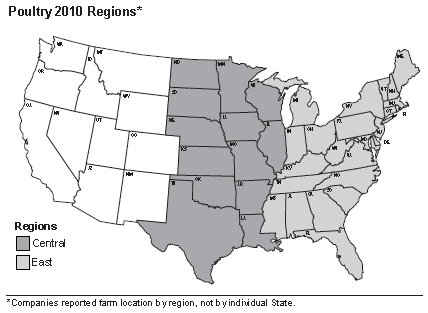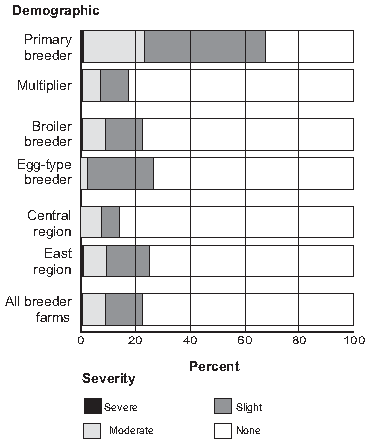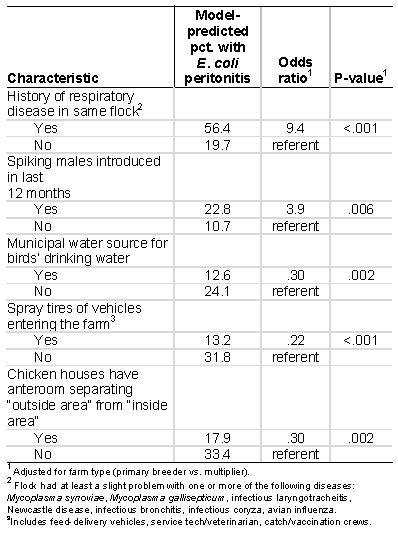



E. coli Peritonitis on Breeder Chicken Farms in the United States
E. coli peritonitis is a common problem on breeder farms in the US, according to a Technical Brief from APHIS Veterinary Services. This is a report based on the USDA's National Animal Health Monitoring System (NAHMS) study of US breeder-chicken farms in 2010.Breeder-chicken farms consist of primary breeders,
whose progeny are breeding birds, and multipliers,
whose progeny are broilers and table-egg layers.
Breeder farms provide the genetics for the poultry
industry, and the birds on these farms are very valuable.
Therefore, disease can have a substantial economic
impact in these flocks.
Escherichia coli are normal inhabitants of intestinal
tracts and can be found in chicken faeces, litter, dust and
rodent droppings. It may also contaminate feed and
water (Barnes, 2008). E.coli is the most common
bacteria recovered from birds affected with peritonitis, an
infection of the lining of the abdominal cavity (Barnes,
2008; Beckman, 2006). E.coli is frequently a secondary
infection; tissues damaged by viral infections are
susceptible to secondary bacterial infections. Earlyproduction
E. coli peritonitis in breeder flocks is often
related to the onset of egg production and can be
secondary to respiratory disease. Late-production
infections are often related to vent trauma.
The USDA’s National Animal Health Monitoring
System (NAHMS) conducted a study of US breeder-chicken
farms in 2010. A total of 482 breeder farms
located in the Central region (n=107) and East region
(n=375) of the United States participated in the study
(see map below). The 482 farms consisted of 291 meat-type
(broiler) multiplier farms, 117 meat-type (broiler)
primary breeder farms, 61 table-egg-type multiplier
farms, and 13 table-egg-type primary breeder farms.
The study focused primarily on breeder-farm biosecurity.

Occurrence of E.coli Peritonitis
Breeder farms placed hens in the laying house at 20.9 weeks of age and removed them at 64.1 weeks of age, on average. Breeder farms reported the occurrence and severity of E.coli peritonitis in the last completed flock: 22.7 per cent of all breeder farms had a slight, moderate, or severe problem in the last completed flock. About two-thirds of primary breeder farms (67.7 per cent) had a slight, moderate or severe problem with E.coli peritonitis in the last completed flock (see figure below).

Although data regarding specific causes of mortality were not collected, cumulative flock mortality to 60 weeks of age increased with degree of E.coli peritonitis problems. Flocks with moderate/severe E.coli peritonitis problems had an average mortality of 16.4 per cent compared with 13.6 and 9.8 per cent for flocks with slight and no problems, respectively.
Risk Factors Associated with E.coli Peritonitis
Peritonitis in breeder chickens is most often
associated with the onset of sexual maturity and egg
production. Body weight, flock uniformity, lighting, feed
allocation, temperature and ventilation are important
factors in the disease (Merck 2010). These factors,
however, were not addressed in the NAHMS study,
which focused primarily on biosecurity.
The following analysis identifies biosecurity-related
risk factors for E.coli peritonitis relating to farm
surroundings, farm/house characteristics, human traffic,
birds and other animals on the farm, and bird/egg
movement and transport. For the risk factor analysis,
farms with E.coli peritonitis in the last completed flock
were compared with farms with no E.coli peritonitis
problem in the last completed flock.
Each factor was
evaluated individually and adjusted for farm type
(primary breeder versus multiplier); factors with a p-value
<0.1 were further evaluated in a multivariable logistic
regression model via a backward elimination process
(see table below).
Results are presented as odds ratios.
The odds ratio is the likelihood (odds) of a farm having
E. coli peritonitis in the last completed flock for farms
with the factor compared with farms without the factor.

Farms with a history of respiratory disease in the last
completed flock had an increased risk of E.coli
peritonitis. E.coli is a common secondary infection of the
respiratory tract and may spread from there to the
peritoneal cavity (Barnes, 2008).
Introducing spiking males to a flock — primarily a
practice used by broiler breeders — stimulates breeding
activity through competition between the young, spiking
males and established males. Farms that introduced
spiking males in the 12 months prior to the survey were
more likely to experience E.coli peritonitis in the last
completed flock (OR=3.9). This practice may increase
the stress level of birds in the flock.
Using a municipal water source for birds’ drinking
water was associated with a reduced risk of E.coli
peritonitis. Chlorination of municipal water may reduce
E.coli contamination.
Biosecurity measures help prevent the introduction
of disease pathogens that may secondarily predispose
birds to E.coli peritonitis. Two biosecurity measures
were negatively associated with E. coli peritonitis:
- Providing an anteroom that separates'outside area' from 'inside area'
- Spraying tires of vehicles entering the premises.
Summary
E.coli peritonitis is a common problem on breeder
farms.
Flock mortality increases with severity of E.coli
peritonitis. Flocks experiencing respiratory disease and
farms that introduce spiking males have an increased
risk of disease, while farms that use a municipal water
source for birds’ drinking water have a reduced risk of
disease.
Biosecurity measures are important for
preventing the introduction of disease pathogens, which
may lead to secondary E.coli infections.
Management of the poultry-house environment (e.g. temperature,
lighting, ventilation, etc.) is also important for preventing
E.coli peritonitis but was not addressed by this study.
References
Barnes J. 2008. Diseases of Poultry, 12th ed. Blackwell Publ., Ames, IA. 706–707.
Beckman B. 2006. Current perspectives on peritonitis. Accessed July 16, 2012.
Kahn C., ed. 2010. Egg peritonitis. In: Merck Veterinary Manual








